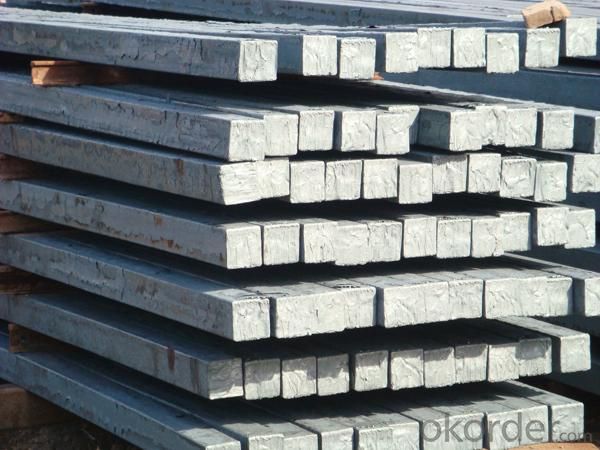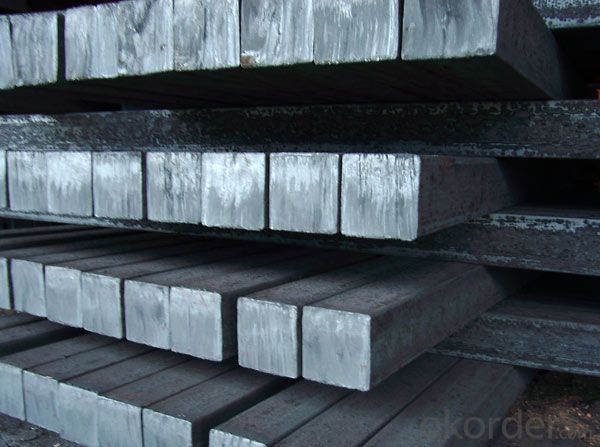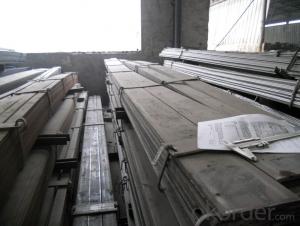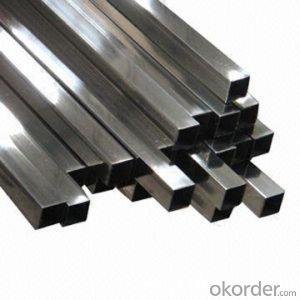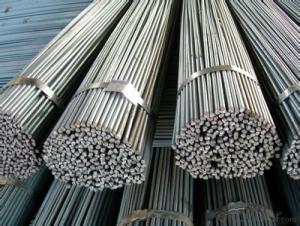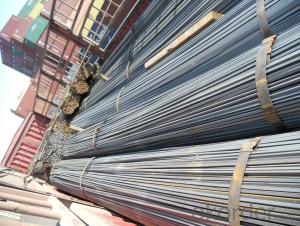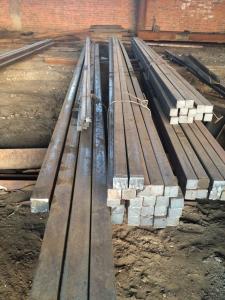Hot Rolled Square Bar with High Quality of Grade Q235,Q275
- Loading Port:
- Tianjin
- Payment Terms:
- TT or LC
- Min Order Qty:
- 3000 m.t.
- Supply Capability:
- 100000 m.t./month
OKorder Service Pledge
OKorder Financial Service
You Might Also Like
Product Description:
OKorder is offering Hot Rolled Square Bar with High Quality of Grade Q235,Q275 at great prices with worldwide shipping. Our supplier is a world-class manufacturer of steel, with our products utilized the world over. OKorder annually supplies products to European, North American and Asian markets. We provide quotations within 24 hours of receiving an inquiry and guarantee competitive prices.
Product Applications:
Hot Rolled Square Bar with High Quality of Grade Q235,Q275 are ideal for structural applications and are widely used in the construction of buildings and bridges, and the manufacturing, petrochemical, and transportation industries.
Product Advantages:
OKorder's Hot Rolled Square Bar with High Quality of Grade Q235,Q275 are durable, strong, and resist corrosion.
Main Product Features:
· Premium quality
· Prompt delivery & seaworthy packing (30 days after receiving deposit)
· Corrosion resistance
· Can be recycled and reused
· Mill test certification
· Professional Service
· Competitive pricing
Product Description:
-Standard: Q235 Q275
--Chemical Composition:
Standard | Grade | Element (%) | ||||
GB | Q235/275 | C | Mn | S | P | Si |
0.06~0.12 | 0.25~0.50 | ≤0.050 | ≤0.045 | ≤0.30 | ||
Measures of HR Square Bar (small measures):
(Section of HR Square Bar)
-Length of a side and Theoretical weight of Square Bar.
Length of a side(mm) | Theoretical weight(kg/m) | Length of a side(mm) | Theoretical weight(kg/m) |
7 | 0.385 | 22 | 3.80 |
8 | 0.502 | 24 | 4.52 |
9 | 0.636 | 25 | 4.91 |
10 | 0.785 | 26 | 5.30 |
11 | 0.950 | 28 | 6.15 |
12 | 1.13 | 30 | 7.06 |
13 | 1.33 | 32 | 8.04 |
14 | 1.54 | 34 | 9.07 |
15 | 1.77 | 36 | 10.17 |
16 | 2.01 | 38 | 11.24 |
17 | 2.27 | 40 | 12.56 |
18 | 2.54 | 42 | 13.85 |
19 | 2.82 | 45 | 15.90 |
20 | 3.14 | 48 | 18.09 |
21 | 3.46 | 50 | 19.63 |
Notes:
1, The theoretical weights in the list, base on the density of 7.85 g/cm3.
2, Formula for theoretical weight of Square bar: (length of a side)2 * 0.00785
3, The numbers with *mean that they are not regular or we don’t offer them.
-Regular length of Square Bar:
Steel | Length of a side (mm) | Length of steel (m) |
Normal steel | < 25 | 4~10 |
> 25 | 3~9 | |
Steel of high quality | All measure | 2~6 |
Tool steel >75 | 1~6 |
Usage/Applications of HR Square Bar:
-The Square Bar is normally used as structure steel.
-Row material for other structure steel like steel angles, channels, I-beams, H-beams, etc…
Packaging & Delivery of HR Square Bar:
-Packing Detail: The products can be packed in bundles by steel wires.
-Marks: We make tag marks and color marks. The tag marks with white background and red company logo will be tied up to each bundle of the products. The information is usually including basic information of products and company and other information requested by customers. As for color marks, we will paint both ends of bundles to make sure that it will be more convenient for customers to distinguish them from other products.
-Delivery Detail: 30~45 working days after receive buyer’s T.T. or L/C.
Transportation:
-The products can be delivered by bulk vessel or by container. As for container, products with the length of 6m will be loaded in 20’ container, with 9m or 12m, in 40’ container.
-The maximum quantity of loading of container is 25 tons.
-The products are usually transported to the nearest port from the production place.
FAQ:
Q1: Why buy Materials & Equipment from OKorder.com?
A1: All products offered byOKorder.com are carefully selected from China's most reliable manufacturing enterprises. Through its ISO certifications, OKorder.com adheres to the highest standards and a commitment to supply chain safety and customer satisfaction.
Q3: How soon can we receive the product after purchase?
A3: Within three days of placing an order, we will begin production. The specific shipping date is dependent upon international and government factors, but is typically 7 to 10 workdays.
Q4: What makes stainless steel stainless?
A4: Stainless steel must contain at least 10.5 % chromium. It is this element that reacts with the oxygen in the air to form a complex chrome-oxide surface layer that is invisible but strong enough to prevent further oxygen from "staining" (rusting) the surface. Higher levels of chromium and the addition of other alloying elements such as nickel and molybdenum enhance this surface layer and improve the corrosion resistance of the stainless material.
Image:
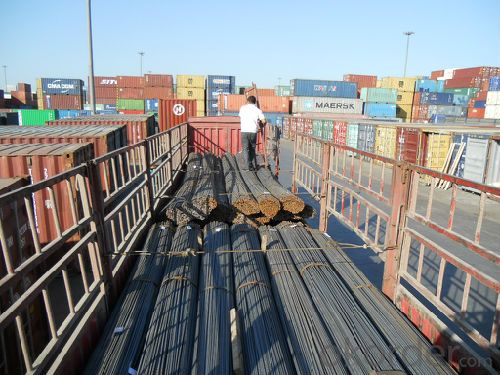
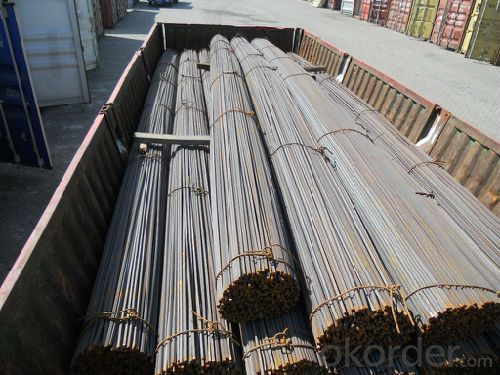
- Q: What are the different quality control measures for steel billets?
- To ensure the high quality of steel billets, several quality control measures are implemented during their production and inspection. These measures encompass: 1. Thoroughly analyzing the chemical composition of steel billets to ensure it aligns with the required specifications. This analysis involves determining the content of elements like carbon, manganese, sulfur, phosphorus, and others. Any deviations from the specified composition can impact the mechanical properties of the billets. 2. Verifying the size, shape, and weight of steel billets through dimensional inspection. This entails measuring the length, width, and thickness of the billets using precision instruments and ensuring they meet the specified tolerances. Any deviations from the required dimensions can affect the billets' performance during subsequent processing. 3. Inspecting the surface of steel billets for defects or irregularities. This includes checking for cracks, surface discontinuities, surface roughness, and other imperfections. Surface inspection is typically conducted using visual inspection techniques or non-destructive testing methods like magnetic particle testing or ultrasonic testing. 4. Conducting mechanical testing to assess the mechanical properties of steel billets. This involves tests such as tensile testing, hardness testing, and impact testing to determine the billets' strength, ductility, toughness, and other mechanical characteristics. These tests ensure that the billets possess the required mechanical properties for their intended applications. 5. Examining the microstructure of steel billets through metallurgical examination. This helps identify any defects in the metal structure, such as grain size, segregation, inclusions, or improper heat treatment. By assessing the metallurgical properties, the quality control team can ensure that the billets are free from any internal defects that might compromise their structural integrity. 6. Using non-destructive testing techniques like ultrasonic testing, magnetic particle testing, or eddy current testing to detect internal defects or discontinuities that may not be visible through visual inspection. These methods allow for the detection of flaws without damaging the billets, ensuring their integrity is maintained. 7. Maintaining proper documentation and traceability throughout the production process. This involves documenting the results of all inspections, tests, and analyses performed on the steel billets, as well as tracking their origin, processing history, and any relevant certifications. This documentation ensures transparency and enables traceability in case of any quality-related issues. By implementing these quality control measures, steel manufacturers can ensure that the produced billets meet the required specifications, possess the desired properties, and are of high quality. This enhances their reliability and suitability for various applications in industries such as construction, automotive, and manufacturing.
- Q: What are the factors that affect the price of steel billets?
- There are several factors that can affect the price of steel billets. 1. Raw material costs: The cost of iron ore, coal, and other raw materials used in steel production can significantly impact the price of steel billets. Any fluctuations in these costs can directly influence the price of steel billets. 2. Demand and supply: The supply and demand dynamics of steel billets play a crucial role in determining their price. An increase in demand for steel products, such as construction materials or automotive parts, can drive up the price of steel billets. Conversely, an oversupply of steel billets can lead to a decrease in price. 3. Energy costs: The cost of energy, including electricity and fuel, required for steel production can impact the price of steel billets. Fluctuations in energy prices can affect the overall production cost and, subsequently, the price of steel billets. 4. Currency exchange rates: Steel billets are often traded on international markets, and currency exchange rates can have a significant impact on their price. If the currency of the country producing steel billets weakens against other currencies, it can make the product more affordable and potentially increase demand. 5. Trade policies and tariffs: Government regulations, trade policies, and tariffs imposed on steel billets can influence their price. Tariffs can increase the cost of imported steel billets, making domestically produced steel billets relatively more competitive and potentially leading to higher prices. 6. Economic factors: The overall state of the economy, both locally and globally, can impact the price of steel billets. During periods of economic growth, there is typically higher demand for steel products, which can drive up the price of steel billets. Conversely, during economic downturns, demand may decrease, resulting in lower prices. 7. Technological advancements: Innovations in steel production technology can impact the price of steel billets. Advancements that increase efficiency and reduce production costs can potentially lead to lower prices, while new technologies that improve the quality or properties of steel billets may command a higher price. It is important to note that these factors are interconnected and can influence each other. Therefore, understanding the complex relationship between these factors is essential in analyzing and predicting the price of steel billets.
- Q: What are the potential applications of steel billets in the electronics aftermarket?
- Steel billets have numerous potential applications in the electronics aftermarket. One possible application is the production of electronic enclosures or casings. Steel billets can be machined and shaped into various forms and sizes to create sturdy and reliable enclosures that protect electronic components. These enclosures provide durability and protection against environmental factors such as moisture, dust, and impact. Additionally, steel billets can be used in the manufacturing of various electronic components. For example, they can be utilized to create connectors, pins, sockets, and other small parts that are essential for electronic devices. Steel's high strength and conductivity make it an ideal material for these components, ensuring reliable performance and efficient signal transmission. Furthermore, steel billets can be employed in the production of heat sinks for electronic devices. Heat sinks are crucial in dissipating heat generated by electronic components and preventing overheating, which can lead to performance issues or even component failure. Steel's excellent thermal conductivity makes it a suitable material for heat sinks, allowing efficient heat transfer and ensuring the proper functioning of electronic devices. Moreover, steel billets can be utilized in the manufacturing of racks and cabinets used for housing and organizing electronic equipment. These structures provide a safe and secure environment for storing and accessing electronic devices in various settings, such as data centers, telecommunications facilities, or server rooms. Steel's durability and load-bearing capabilities make it an ideal choice for such applications, ensuring the protection and organization of electronic equipment. In summary, steel billets have a range of potential applications in the electronics aftermarket. Whether it is in the production of enclosures, electronic components, heat sinks, or racks and cabinets, steel's strength, conductivity, durability, and thermal properties make it a versatile material for various electronic applications.
- Q: What are the different types of steel billet surface treatments?
- There are several different types of steel billet surface treatments, including pickling, shot blasting, and painting. Pickling involves removing impurities and oxides from the surface of the billet using an acid solution. Shot blasting is a process in which small metallic or abrasive particles are blasted onto the surface of the billet to remove rust, scale, and other contaminants. Painting involves applying a protective coating or layer of paint to the surface of the billet to prevent corrosion and improve its appearance.
- Q: What are the specifications for tool steel billets used in the tooling industry?
- Tool steel billets used in the tooling industry typically have specific specifications to ensure optimal performance and durability. These specifications include: 1. Composition: Tool steel billets are made from specific alloy compositions that provide high hardness, wear resistance, and toughness. Common elements found in tool steel include carbon, chromium, vanadium, molybdenum, and tungsten. 2. Hardness: Tool steel billets are heat-treated to achieve a desired hardness level, typically measured in Rockwell hardness (HRC). The hardness required depends on the specific application and the type of tool being produced. 3. Size and shape: Tool steel billets come in various sizes and shapes, such as rectangular or round bars, to cater to different tooling requirements. The dimensions of the billets are chosen based on the size and complexity of the tool being manufactured. 4. Surface finish: Tool steel billets should have a smooth and clean surface finish to ensure easy machining and minimize the risk of defects or imperfections in the final tooling product. 5. Tolerance: The billets should be manufactured with tight dimensional tolerances to ensure consistency during the machining and tooling processes. This helps in achieving precise tool dimensions and minimizing wastage. 6. Homogeneity: Tool steel billets should have uniform chemical composition and microstructure throughout to ensure consistent mechanical properties and performance of the final tooling products. 7. Heat treatment properties: The billets should have good heat treatment properties, including the ability to be hardened and tempered, to enhance their strength, toughness, and wear resistance. 8. Machinability: Tool steel billets should have good machinability to allow for efficient shaping and forming processes during tool manufacturing. This includes considerations for cutting forces, chip formation, and surface finish. It is important to note that the specific specifications for tool steel billets can vary depending on the application and the type of tool being produced. Manufacturers and tooling experts often work closely together to determine the most suitable tool steel specifications for each specific tooling requirement.
- Q: What are the main differences between hot-rolled and cold-rolled steel billets?
- The main differences between hot-rolled and cold-rolled steel billets lie in the manufacturing process and the resulting characteristics of the steel. Hot-rolled steel billets are produced by heating the steel above its recrystallization temperature, typically around 1200°C (2200°F), and then rolling it into the desired shape or size. This process involves the use of large-scale machinery, such as rolling mills, which apply significant pressure to shape the steel. As a result, hot-rolled steel billets have a characteristic rough and scaled surface. On the other hand, cold-rolled steel billets are produced by further processing the hot-rolled steel. The hot-rolled steel is first cooled down to room temperature and then passed through a series of rollers at lower temperatures, typically below 1000°C (1832°F). This process provides more precise control over the dimensions and surface finish of the steel. Cold-rolled steel billets have a smoother and more polished appearance compared to their hot-rolled counterparts. In terms of physical and mechanical properties, hot-rolled steel billets tend to have a higher yield strength and lower ductility compared to cold-rolled steel. This is because the hot-rolling process causes the steel to undergo strain hardening, resulting in increased strength but reduced ability to deform without breaking. Cold-rolled steel, on the other hand, retains more of its ductility due to the controlled process of rolling at lower temperatures. Another significant difference is in the dimensional accuracy of the two types of steel billets. Hot-rolled steel billets are known to have larger dimensional tolerances, which means that there can be variations in the thickness, width, and length of the billets. In contrast, cold-rolled steel billets have tighter dimensional tolerances, resulting in more precise and consistent dimensions. In summary, the main differences between hot-rolled and cold-rolled steel billets lie in the manufacturing process, surface finish, physical and mechanical properties, and dimensional accuracy. Understanding these differences is crucial for selecting the appropriate type of steel billets for specific applications, as each type has its own advantages and disadvantages.
- Q: What are the main uses of steel billets?
- Steel billets are semi-finished steel products that are commonly used in various industries. The main uses of steel billets include: 1. Steel production: Steel billets serve as the starting point for the production of various steel products. They are used in the manufacturing of bars, rods, wire, and structural sections, among other steel products. 2. Construction industry: Steel billets are extensively used in the construction industry for the production of beams, columns, and other structural elements. These billets are often rolled into specific shapes and sizes to meet the demands of construction projects. 3. Automotive industry: Steel billets are used in the automotive industry for the production of various components, such as crankshafts, camshafts, axles, and gears. These billets are further processed to form the desired shapes and sizes required for these components. 4. Machinery and equipment manufacturing: Steel billets find applications in the manufacturing of machinery and equipment. They are used to produce parts and components that require high strength and durability, such as gears, shafts, and bearings. 5. Pipe and tube manufacturing: Steel billets are an essential raw material used in the production of pipes and tubes. They are heated and pierced to form seamless tubes or rolled and welded to produce welded tubes. These tubes find applications in various industries, including oil and gas, construction, and automotive. 6. Forging industry: Steel billets are widely used in the forging industry for the production of forged components, such as crankshafts, connecting rods, and valves. The billets are heated and then shaped using pressure and heat to achieve the desired shape and strength. 7. Shipbuilding industry: Steel billets are utilized in the shipbuilding industry for the construction of ship hulls, frames, and other structural components. These billets provide the necessary strength and durability required for marine applications. In summary, steel billets serve as the raw material for the production of a wide range of steel products used in various industries, including construction, automotive, machinery manufacturing, pipe and tube manufacturing, forging, and shipbuilding.
- Q: 20 what is the difference between manganese silicon steel billet and Q235 billet?
- In brief, the ingredients are different and the uses are different.
- Q: What are the different types of defects that can occur during steel billet production?
- During the production of steel billets, various defects may arise, which can compromise the quality and performance of the final product. Some commonly observed defects in steel billets include the following: 1. Surface Defects: These defects manifest on the billet's surface and may include scales, cracks, pits, scars, and slivers. Improper handling, inadequate lubrication, insufficient heating, or contamination during the manufacturing process can cause surface defects. 2. Internal Defects: Internal defects occur within the billet and can be more challenging to detect. Examples of internal defects include voids, porosity, inclusions, and segregation. Improper alloying, inadequate mixing, or flawed casting and solidification processes can lead to internal defects. 3. Shape Defects: Shape defects refer to deviations from the desired dimensions or geometry of the billet. These defects may include bending, bowing, twisting, or excessive tapering. Improper rolling or cooling processes, inadequate maintenance of rolling equipment, or mishandling of billets can cause shape defects. 4. Chemical Composition Defects: Steel billets must meet specific chemical composition requirements to ensure desired material properties. Defects in chemical composition may occur due to improper mixing of raw materials, incorrect temperature control, or contamination during the manufacturing process. Such defects can negatively impact the mechanical properties of the final product, such as strength, ductility, or corrosion resistance. 5. Incomplete Solidification: Defects like centerline segregation or shrinkage cavities can arise from incomplete solidification. This occurs when the cooling rate is too fast or uneven, preventing the complete solidification of the billet. Incomplete solidification weakens the billet structure, affecting its overall integrity and performance. 6. Dimensional Defects: Dimensional defects involve variations in the size, length, width, or thickness of the billet. These defects may result from inaccurate measurement or control during the manufacturing process. Dimensional defects can hinder the fitment or compatibility of the billet in subsequent processes or applications. To minimize the occurrence of these defects, steel billet manufacturers must implement rigorous quality control measures. Regular inspections, process optimization, and adherence to industry standards and best practices can help mitigate defects and ensure the production of high-quality steel billets.
- Q: How do steel billets contribute to the sustainability of construction projects?
- Steel billets contribute to the sustainability of construction projects in several ways. Firstly, steel is a highly durable and long-lasting material, ensuring that structures built with steel billets have a longer lifespan and require less maintenance and repairs over time. This longevity reduces the need for frequent reconstruction, saving resources and minimizing waste. Additionally, steel is a recyclable material, meaning that steel billets can be reused or repurposed at the end of their life cycle, reducing the demand for new steel production and lowering the environmental impact. Lastly, steel's strength-to-weight ratio allows for lighter and more efficient designs, resulting in reduced material consumption and energy usage during construction. Overall, the use of steel billets in construction projects promotes sustainability by enhancing durability, facilitating recycling, and optimizing resource efficiency.
Send your message to us
Hot Rolled Square Bar with High Quality of Grade Q235,Q275
- Loading Port:
- Tianjin
- Payment Terms:
- TT or LC
- Min Order Qty:
- 3000 m.t.
- Supply Capability:
- 100000 m.t./month
OKorder Service Pledge
OKorder Financial Service
Similar products
Hot products
Hot Searches
Related keywords





